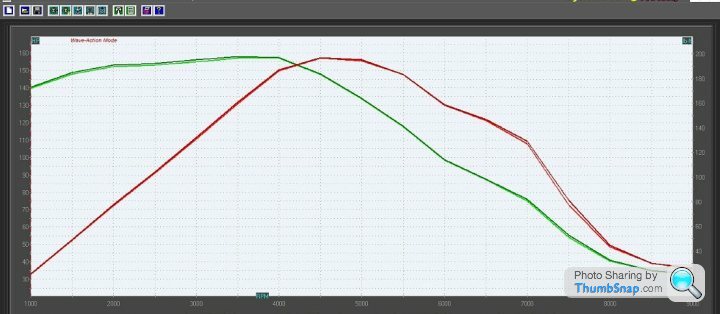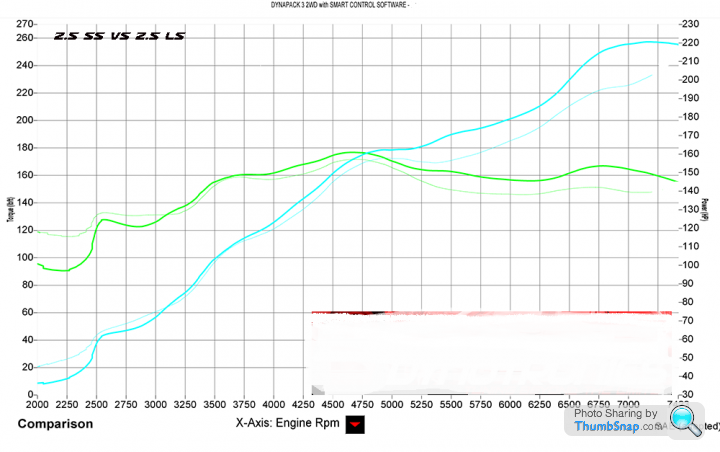Big bore, short stroke or narrow bore, long stroke?
Discussion
I've just been reading about a two identical engines, both 2.5 inline fours.
Identical specification except for one thing, they changed the bore/stroke ratio.
The LS was 100 stroke, 89 bore
The SS was 94 stroke, 92 bore.
If the RPM limit was the same on both (7k) would the power outputs be the same?
Yes I know the SS will have a more 'revvy' nature, the potential to rev further safely and make more power, but if it hasn't been exploited (with a change in spec) would it give the same power output?
Identical specification except for one thing, they changed the bore/stroke ratio.
The LS was 100 stroke, 89 bore
The SS was 94 stroke, 92 bore.
If the RPM limit was the same on both (7k) would the power outputs be the same?
Yes I know the SS will have a more 'revvy' nature, the potential to rev further safely and make more power, but if it hasn't been exploited (with a change in spec) would it give the same power output?
GreenV8S said:
Same rod/stroke ratio, cam profile, intake and exhaust characteristics?
Cam profile, intake and exhaust are the same, even timed the same.Rod/stroke ratio is a bit better on the SS, but is that much of an issue? A lot of people say the dwell at TDC makes more power, but then the more modern thinkers say not, or at least if it does it's only worth about 1 - 3 bhp on a 2 -- 2.5 litre engine. If you'd like to debate that (and it's an important part of this thread) i'd like to see some hard evidence that it works.
Mignon said:
Yes.
Yes I think so too.Max_Torque said:
For any given cylinder capacity, all the "short stroke" architecture is able to make more power because:
1) A bigger bore gives more room for bigger valves. Bigger valves support a greater cylinder filling at any given speed, and hence increase BMEP
2) The shorter stroke reduces piston speed, which reduces friction, and ultimately, peak piston speed becomes limiting
(There is no geometric advantage, because for a given CC, stroke and piston area cancel)
2. There will be greater friction from the bigger bore, whether it will reduce or cancel out any of the gains I don't know.1) A bigger bore gives more room for bigger valves. Bigger valves support a greater cylinder filling at any given speed, and hence increase BMEP
2) The shorter stroke reduces piston speed, which reduces friction, and ultimately, peak piston speed becomes limiting
(There is no geometric advantage, because for a given CC, stroke and piston area cancel)
stevieturbo said:
JoeBolt said:
I wasn't responding to your post Mignon but to the simple suggestion I quoted that an increase in surface area causes an increase in friction, (all other parameters being equal).
However, I dispute your suggestion that a longer stroke equates to an increase in friction. In the block diagram above, the force to keep the block moving will stay constant whether the block is being moved an inch or a mile, assuming the nature of the surfaces remains constant. If the force remains constant, then the friction being overcome must also remain constant.
What does increase with distance is work.
Work against friction = Force of friction x Distance
But in your block example.....not too many engines have that force applied at 90deg throughout....rod angle, thrust loads etc etc all play a partHowever, I dispute your suggestion that a longer stroke equates to an increase in friction. In the block diagram above, the force to keep the block moving will stay constant whether the block is being moved an inch or a mile, assuming the nature of the surfaces remains constant. If the force remains constant, then the friction being overcome must also remain constant.
What does increase with distance is work.
Work against friction = Force of friction x Distance
Just to wrap this up I managed to get some time on a Dyno simulation program, below is a comparison between the two, the lighter trace is the long stroke:

I didn't expect any more bhp or torque for either, but was mildly surprised just how close they were throughout the rev range.
Below is what someone claimed they were doing on an actual hub dyno:



I didn't expect any more bhp or torque for either, but was mildly surprised just how close they were throughout the rev range.
Below is what someone claimed they were doing on an actual hub dyno:


Gassing Station | Engines & Drivetrain | Top of Page | What's New | My Stuff



